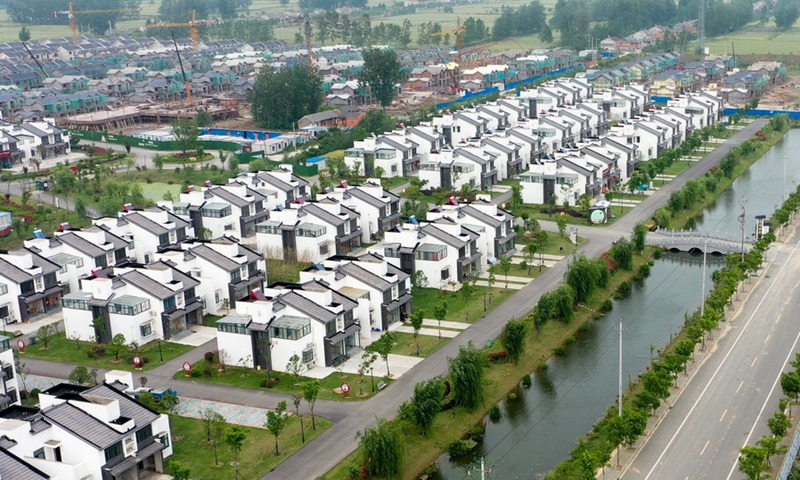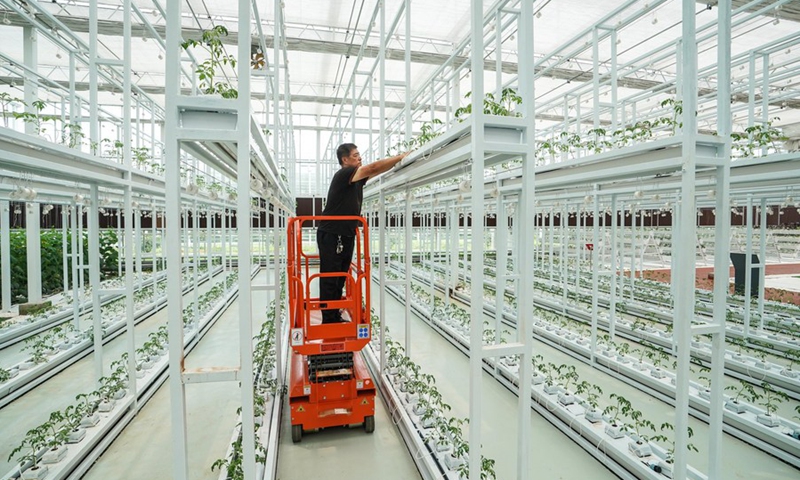
Aerial photo taken on May 11, 2020 shows residential houses built for farmers in Lyuliang Township of Jinhu County, east China's Jiangsu Province.(Photo: Xinhua)

Ye Yuzhu introduces tea to the audience via livestreaming at the tea market in Songyang County of Lishui City, east China's Zhejiang Province, Feb. 25, 2021.(Photo: Xinhua)

An employee works at a modern agricultural industrial park in Lianyungang City, east China's Jiangsu Province, July 13, 2019. (Photo: Xinhua)
On a drizzly fresh morning, Lu Panfeng, 45, was inspecting and recording the conditions of wheat in the city of Huai'an, east China's Jiangsu Province. Once utterly obscure, he was awarded as a national role model for efforts in poverty alleviation at the Great Hall of the People in Beijing last month.
During the past eight years, as the Party chief of Fengnian village in Huai'an, once a poverty-stricken village, Lu has worked out a busy schedule to lead his villagers out of abject deprivation by developing local agricultural collectives and distinctive industries.
In 2020, the collective incomes of the village notched up 1 million yuan (about 153,000 U.S. dollars), quadrupling that of two years ago.
Over the last eight years, China's final 98.99 million impoverished rural residents living below the subsistence level declared poverty-free. The country then met the poverty eradication target set out in the United Nations' 2030 Agenda for Sustainable Development a decade ahead of schedule.
To ensure that those who have been lifted out of poverty will not be snapped back into impoverishment, China will implement strategies including rural vitalization in an all-around manner during the 14th Five-Year Plan (2021-2025) period, safeguarding the sound development of modern agriculture and increasing income for farmers.
Revamping Industries
Graduated from the Shanghai-based Tongji University, Fan Yajun worked in sales and promotion in a pharmaceutical enterprise before she chose to become a tech-savvy farmer in the city of Jurong.
Jurong, a county-level city under the administration of Zhenjiang in Jiangsu, is well-known for its strawberries.
Born in the city next to Jurong, Fan was familiar with and interested in strawberry-growing. She decided to establish the Jiangsu Esperanza Eco-Agriculture Technology Co., Ltd., helping local farmers cultivate seedlings and standardize planting strawberries and pitaya.
Different from the traditional planting patterns, Fan introduced the industrialization path to develop the value chain and supply chain of strawberries, which mainly includes breeding, marketing, processing and agro-tourism. Her company also cooperated with some research institutions to develop tens of new varieties of strawberries.
"We can produce about 3 million plants of strawberries every year, generating an annual income of over 1 million yuan," said Fan.
Over the past eight years, China has built 1,290 innovation and entrepreneurial platforms in its rural backwaters and about 289,800 sci-tech experts have been sent to those areas since the 18th National Congress of the Communist Party of China held in 2012.
Many in rural China are also jumping on the livestreaming bandwagon to expand the sales channels for their produce.
As a migrant worker in southwest China's Sichuan Province, Liang Guanhua came back to his hometown Haiqi Village in the city of Lianyungang, Jiangsu. Liang now serves as a livestreaming host to sell seafood.
"I earn more money now and a growing number of youngsters are heading back home for living," Liang said.
Home to more than 1,100 households, Haiqi sees over one-fourth of its residents occupied in the e-commerce sector now. Thanks to the new business model, the annual seafood sales in the village can reach around 2 billion yuan, according to Li Jiashi, Party chief of the village.
To achieve rural vitalization, the Ministry of Agriculture and Rural Affairs vowed to focus on four key tasks. Among these tasks, more will be done to improve rural industries, including the agricultural product processing industry, all for more job opportunities in rural China.
Upgrading Tourism
Being at the northernmost tip of China and over 130 km away from urban districts, Beihong Village is tucked away in mountains in the city of Mohe, northeast China's Heilongjiang Province.
The village suffers from minus 40 degrees Celsius during its extremely long winter, which often lasts from November to the end of April. The harsh weather causes poor harvest, cutting the main income source for the villagers and making their hometown one of the poorest in Heilongjiang as late as in 2014.
The village has 146 households and 366 residents. With Russia visible directly across the Heilongjiang River in its north, at least a quarter of its villagers have Russian blood and can be recognized by their blueish eyes, large noses and curly hair.
Approved as a Russian ethnic village by the State Ethnic Affairs Commission in 2008, the village has maintained the elaborate layout of its original, preserving over 100 Russian-style houses built with logs and strips. Wandering around the village, travelers can soon get away from the bustling urban life and find their inner peace.
The sleepy village's road to tourism boom largely relies on poverty alleviation programs launched over the years.
In 2011, the village was connected to the State Grid. Previously, electricity was almost a luxury. The residents could only rely on the diesel generator for about three hours of electricity supply a night.
In the next few years, new roads were built and the Internet was made accessible for the place. Now, the aurora that can be seen around the Summer Solstice, extreme coldness as well as the village's northernmost location have become a big draw for tourists.
Zhang Fushun, a local villager, still recalled a bitterly cold afternoon in 2010, when two female tourists were trying hard for an inn to stop over but there was none of such thing in the village.
The warm-hearted Zhang thus invited them to his house, asking his wife to cook some meals. To his surprise, the two were quite hesitant to eat the rural dishes because they were reluctant to use the outdoor toilet.
"I will not forget the despair shown in their faces when leaving the village," Zhang said. In the following years, he renovated his house and his priority was to build an indoor bathroom. Zhang became one of the first to operate a family inn.
Currently, 72 family inns and four supermarkets are run by the locals. It is calculated that more than 200 people out of the 366 villagers are directly involved in the tourism industry. In 2018, all impoverished households in the village escaped penury.
Turbocharging Construction
Peng Rui, a 41-year-old university lecturer in Jiangsu's city of Suzhou, spends most of his spare time in Shushan Village as a designer in rural planning.
In 2012, the village committee invited the teaching staff in Suzhou University of Science and Technology to engage in village planning and Peng was among them.
The village with over 400 households has its specialties of tea, pears and red bayberries. "I felt like Shushan has so many good natural resources, just a pearl covered in dust," Peng said.
In the first four years, the village mainly focused on beautifying the environment, including redesign and renovate the houses, and build infrastructures like gas pipelines and hot springs.
"Villagers were invited to visit our design and most of them were impressed and volunteered to have a try," Peng said.
In 2016, Peng envisioned a cluster of startups and opened a center that attracted over 60 startups in rural and cultural creative industries. Via the platform, Peng and his team have organized multiple activities including various conferences and tourism festivals. They have also built a recording studio and invited musicians and bands to hold shows and opened two public libraries at the foot of the mountains, enhancing the cultural experience for the locals and tourists.
"Where there is scenery, there is new economy," he said. Shushan is now like a magnet that has attracted two coffee shops, 13 homestays and even a five-star international hotel chain. Villagers at Shushan sold 55 million yuan worth of agricultural products in 2020. Their per capita income exceeded 45,000 yuan.
During the 14th Five-Year Plan period (2021-2025), China will make efforts to advance rural construction to improve rural residents' living standards and satisfy their need of building a beautiful countryside, Minister of Agriculture and Rural Affairs Tang Renjian said in a recent interview with Xinhua.
According to the action plan for rural construction, China will set targets for better rural public infrastructure and basic public services, stronger rural consumption and faster integrated urban-rural development within counties.
